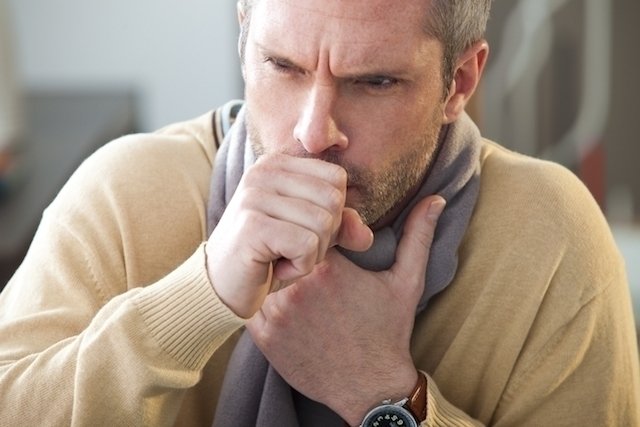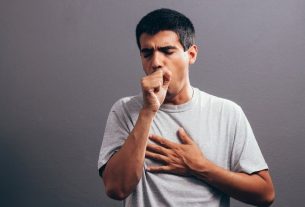Yellow phlegm is usually a sign of some type of bacterial infection, such as sinusitis, pharyngitis, bronchitis or even pneumonia, for example.
This happens mainly because, when there are bacteria developing, the mucus becomes thicker to stick to the microorganisms and eliminate them through coughing, taking on a more yellowish color. As the infection worsens, it is possible that the color of the phlegm will also change, becoming more greenish. See what green phlegm could indicate and what to do.
When yellow phlegm appears, especially accompanied by other symptoms such as fever, sore throat or shortness of breath, it is important to consult a pulmonologist to identify the cause and begin the most appropriate treatment.
What can be yellow phlegm
The most common causes of yellow phlegm are:
1. Pharyngitis
Another cause of yellow phlegm is bacterial pharyngitis, which is characterized by inflammation of the pharynx. Due to the presence of bacteria, in addition to phlegm, other symptoms may appear such as an intense sore throat, difficulty swallowing, fever and headache. Discover the main symptoms of pharyngitis and how to treat it.
What to do: In case of suspected pharyngitis, it is important to consult a general practitioner so that the symptoms can be assessed and the most appropriate treatment can be indicated, which is normally done with antibiotics, anti-inflammatories and analgesics, which reduce inflammation of the pharynx, relieve pain and reduce fever.
2. Sinusitis
The presence of yellow phlegm may be associated with bacterial sinusitis, which occurs due to inflammation of the nasal sinuses caused by bacteria.
In these cases, in addition to phlegm, it is normal for other symptoms to appear, such as a frequent runny nose, fever, headache and difficulty breathing due to a blocked nose. Find out the symptoms of bacterial sinusitis and its treatment.
What to do: The treatment of bacterial sinusitis must be indicated by the otorhinolaryngologist after an assessment of the symptoms, but the use of antibiotics is usually indicated. In addition, it may be recommended to inhale water vapor to help unclog your nose, allowing you to breathe better.
3. Bronchitis
Yellow phlegm can appear in the case of bronchitis caused by bacteria, as the bronchi become inflamed and produce thicker phlegm to eliminate the bacteria through coughing.
When there is bronchitis, in addition to yellow phlegm, it is normal for other symptoms to appear, such as cough, shortness of breath, fever and tiredness. Understand everything about bronchitis, symptoms, causes and treatment.
What to do: When phlegm is associated with other signs of bronchitis, it is important to consult a pulmonologist to evaluate the symptoms and indicate the most appropriate treatment, which is usually done with bronchodilators, anti-inflammatories, corticosteroids and expectorants. Additionally, it is important to drink plenty of fluids to help the mucus come out more easily.
4. Pneumonia bacteriana
Bacterial pneumonia is not normally contagious and can be one of the causes of yellow phlegm, as it is characterized by the presence of bacteria in the lungs.
In addition to yellow phlegm, bacterial pneumonia can also cause other symptoms such as fever, chest pain, difficulty breathing and coughing, which eliminates bacteria from the lungs.
What to do: The treatment of bacterial pneumonia is carried out with antibiotics and must be recommended by a pulmonologist as all symptoms must be evaluated.
5. Pulmonary bronchiectasis
Yellow phlegm can also be associated with pulmonary bronchiectasis, which is a disease in which the bronchi are more dilated, due to obstruction of the airways or due to the presence of bacteria, which causes the production of thicker mucus.
One of the main symptoms of bronchiectasis is phlegm, however, other symptoms such as coughing up blood, shortness of breath, general malaise and chest pain frequently appear.
What to do: Although there is no cure for pulmonary bronchiectasis, it is possible to undergo treatment, recommended by a pulmonologist, which helps reduce symptoms, relieving discomfort. Treatment can be done with antibiotics and bronchodilators, which make breathing easier. See what pulmonary bronchiectasis is and how it is treated.
Bibliography
- HEALTHLINE. Yellow, Brown, Green, and More: What Does the Color of My Phlegm Mean?. Available at: <https://www.healthline.com/health/green-phlegm>. Accessed on March 2, 2021
- VERYWELL HEALTH. What Causes the Amount of Sputum to Increase?. Available at: <https://www.verywellhealth.com/what-is-sputum-2249192>. Accessed on March 2, 2021
- SHEPHERD, Eileen. Specimen collection 4: procedure for obtaining a sputum specimen. Nursing Times. 113. 10; 49-51, 2017
- SCIENCEDIRECT. Sputum. Disponível em: <https://www.sciencedirect.com/topics/immunology-and-microbiology/sputum>. Acesso em 02 mar 2021
- VIRTUAL HEALTH LIBRARY OF THE MINISTRY OF HEALTH. CHRONIC RESPIRATORY DISEASES. 2010. Available at: <https://bvsms.saude.gov.br/bvs/publicacoes/doencas_respiratorias_cronicas.pdf>. Accessed on March 2, 2021
- MEDICAL NEWS TODAY. What can sputum tell us?. Available at: <https://www.medicalnewstoday.com/articles/318924>. Accessed on March 2, 2021
- VIRTUAL HEALTH LIBRARY OF THE MINISTRY OF HEALTH. Sinusitis. 2011. Available at: <https://bvsms.saude.gov.br/bvs/dicas/235_sinusite.html>. Accessed on March 2, 2021
- KINKADE, Scotte; LONG, Natalie. Acute Bronchitis. Am Fam Physician. 94. 7; 560-565, 2016
- NHS. NATALIE A. LONG. 2017. Available at: <https://www.ouh.nhs.uk/patient-guide/leaflets/files/11194Pbronchiectasis.pdf>. Accessed on March 2, 2021
- WINDFUHR, Jochen et al. Clinical practice guideline: tonsillitis I. Diagnostics and nonsurgical management. NCBI. 273. 4; 973–987, 2016

Sign up for our newsletter and stay up to date with exclusive news
that can transform your routine!
Warning: Undefined array key "title" in /home/storelat/public_html/wp-content/plugins/link-whisper-premium/templates/frontend/related-posts.php on line 12
Warning: Undefined array key "title_tag" in /home/storelat/public_html/wp-content/plugins/link-whisper-premium/templates/frontend/related-posts.php on line 13




